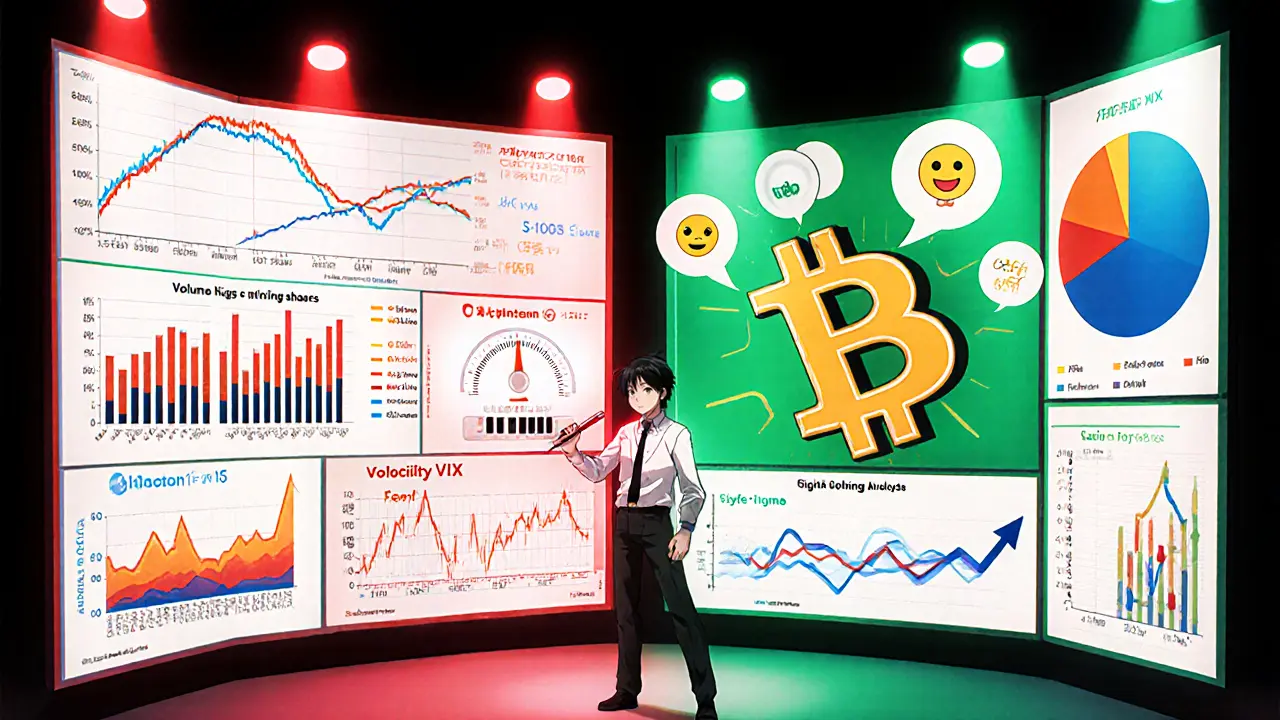Fear and Greed Investment Calculator
What's Your Market Mood?
Enter the current Fear and Greed Index score (0-100) to see recommended investment actions based on the article.
Your Recommendation
Enter a score to see your investment action
The Fear and Greed Index is a sentiment indicator, not a standalone trading system. Always combine with fundamental analysis.
Investors constantly chase a single number that claims to capture the mood of the entire market. That number is the Fear and Greed Index a sentiment gauge that translates dozens of market signals into a single 0‑100 score. Whether you trade S&P500 futures or Bitcoin, understanding how the index is built, what it tells you, and where it falls short can sharpen your timing and keep emotions in check.
Why a Sentiment Gauge Exists
When prices swing wildly, most retail traders look for a quick barometer to tell them whether the crowd is cheering or panicking. Traditional fundamentals-earnings, cash flow, or economic growth-move slowly, but sentiment flips in minutes. The index was invented by CNN Business in 2012 to give a daily snapshot of that flip. A reading of 0 means “extreme fear,” 100 means “extreme greed,” and 50 sits in a neutral zone. The idea is simple: buy when fear is excessive (potential undervaluation) and be cautious when greed dominates (possible overvaluation).
How the Stock‑Market Version Is Calculated
The original version aggregates seven equally weighted metrics. Each metric is first normalized to a 0‑100 scale, then the average yields the final score.
- Price Momentum: S&P500 performance versus its 125‑day moving average. A strong upward deviation pushes the score toward greed.
- Price Strength: Ratio of NYSE stocks hitting 52‑week highs to those hitting lows. A 3:1 high‑low ratio signals greed.
- Price Breadth: Volume of advancing shares vs. declining shares. A 9:1 volume ratio is an extreme greed flag.
- Put/Call Ratio: Ratio of bearish put options to bullish calls. Above0.75 = fear; below0.55 = greed.
- Junk‑Bond Demand: Yield spread between high‑yield (BB‑rated) bonds and 10‑year Treasuries. A spread under 500bps indicates greed.
- Market Volatility (VIX): VIX >30 = fear; VIX <15 = greed.
- Safe‑Haven Demand: Performance difference between stocks and Treasury bonds over 20 trading days. Bonds outperforming stocks by >2% annually point to fear.
All seven components carry the same 14.28% weight, so a single extreme reading can swing the index dramatically.
The Crypto‑Focused Counterpart
In 2018, alternative.me launched a Crypto Fear and Greed Index that tracks Bitcoin and, soon, Ethereum and other altcoins. Its methodology swaps out the equity‑centric metrics for four crypto‑specific ones:
| Component | Stock Index Weight | Crypto Index Weight |
|---|---|---|
| Momentum | 14.28% | 25% |
| Volatility (VIX vs. Crypto Vol) | 14.28% | 25% |
| Social Media Sentiment | - | 15% |
| Dominance Trends (BTC share of crypto market) | - | 10% |
| Price Strength, Breadth, Put/Call, Junk‑Bond, Safe‑Haven | 71.4% | 25% |
Because crypto markets trade 24/7 and react strongly to social chatter, the crypto version leans heavily on volatility and social sentiment. The two indexes share the same 0‑100 scale, but their interpretation diverges during major events. For example, a crypto reading of 90 often coincides with a Bitcoin rally, whereas a stock reading of 90 usually signals a bubble forming in equity valuations.

Historical Extremes and What They Meant
Seeing is believing. During the 2008 financial crisis, the stock index dropped to 12 on September17, 2008. Investors who bought S&P500 ETFs at that trough enjoyed an average 14.2% annual return over the next six years, according to a 2022 study by SmartAsset.
In the pandemic’s first wave, the index hit an all‑time low of 2 on March12, 2020. The market bounced back fast, but the index remained below 30 for weeks, warning that fear was still dominant.
On the crypto side, the index spiked to 95 during Bitcoin’s 2021 bull run, yet many traders who exited at that level missed the subsequent 300% upside that followed the late‑2021 correction.
These cases illustrate the index’s strength as a contrarian signal: extreme fear often precedes rebounds, while extreme greed can foreshadow pullbacks.
Practical Ways to Use the Index
Here’s a step‑by‑step checklist that many retail investors follow:
- Check the daily reading on the CNN Business or alternative.me dashboard.
- If the score is below 20, run a quick fundamentals screen on the assets you’re interested in.
- Allocate a modest portion of your portfolio (5‑15%) to a high‑conviction position if fundamentals look solid.
- If the score is above 80, tighten stop‑losses or consider taking partial profits.
- Document the rationale in a trading journal; avoid acting on the number alone.
Remember, the index is a *trigger*, not a *decision engine*. Combining it with price action, earnings data, or on‑chain metrics (for crypto) yields far better outcomes.
Common Pitfalls and How to Avoid Them
Even seasoned traders stumble over the index. The most frequent mistakes are:
- Treating the score as a precise timing tool. The index tells you the market mood, not the exact moment to buy or sell.
- Ignoring the neutral band (40‑60). Many newbies try to trade when the number is “just right,” but neutrality usually means the market is undecided.
- Overlooking regime shifts. When algorithmic trading dominates (now 60‑70% of NYSE volume), the weight of traditional components may lose predictive power.
Mitigate these risks by always pairing the index with a second filter-be it moving‑average crossovers for stocks or on‑chain activity for Bitcoin.

Future Outlook: Will the Index Still Matter?
Academic research shows the index is gaining citations: 27 papers cited it in 2022 versus just three in 2015. Yet a J.P.Morgan study warns that as more traders watch the same signal, its edge could erode by roughly a third by 2027.
To stay relevant, CNN Business is testing an eighth component-real‑time social‑media sentiment-while alternative.me plans to broaden coverage beyond Bitcoin. If you’re reading this in 2025, expect the index to incorporate AI‑driven sentiment scores and possibly add a crypto‑equity hybrid metric.
Quick Reference Cheat Sheet
- Extreme Fear (0‑20): Look for undervalued assets; consider starting a small position.
- Neutral (40‑60): Market is indecisive; hold steady or wait for clearer signals.
- Extreme Greed (80‑100): Check for overbought conditions; tighten risk management.
- Key Drivers (Stock): Momentum, Strength, Breadth, Put/Call, Junk‑Bond, VIX, Safe‑Haven.
- Key Drivers (Crypto): Momentum, Volatility, Social Sentiment, Dominance.
Frequently Asked Questions
What does a Fear and Greed Index reading of 50 mean?
A score of 50 indicates a balanced market mood-neither fear nor greed dominates. Most traders treat this as a “wait and see” zone.
How often is the index updated?
Both the stock and crypto versions are refreshed once per trading day during market hours. The crypto version updates at 00:00UTC because crypto trades 24/7.
Can the index predict market crashes?
It’s a warning system, not a crystal ball. Extreme fear often precedes rebounds, while extreme greed can hint at a top, but timing the exact crash requires additional analysis.
Is the Crypto Fear and Greed Index reliable for altcoins?
Currently the crypto index focuses on Bitcoin, with plans to add Ethereum and other major altcoins. Until then, its signal for smaller coins is less robust.
Should I trade solely based on the index?
Never. Use it as a sentiment filter and combine it with fundamental or on‑chain analysis. That’s how most successful investors avoid costly false signals.












Mandy Hawks
October 16, 2025 AT 08:10 AMReading through the Fear and Greed Index reminds me how emotions shape markets more than any spreadsheet ever could. It’s a mirror of collective psychology, reflecting when investors collectively shiver or get cocky. In that sense, the index is a living philosophical thought experiment about herd behavior. One could argue that the true value lies not in the number itself, but in how we interpret the underlying sentiment it captures.
Scott G
October 27, 2025 AT 07:10 AMThe methodology outlined for both the equity and crypto versions appears rigorous, with clearly defined components and weighting. However, the reliance on daily snapshots may obscure intra‑day volatility that can be crucial for short‑term traders. It would be prudent to supplement this index with real‑time data feeds when making tactical decisions.
VEL MURUGAN
November 7, 2025 AT 07:10 AMThe explanation of the seven equity components is spot‑on and mathematically sound. I appreciate the inclusion of the junk‑bond spread; it often gets ignored despite being a strong contrarian indicator. For crypto, the social‑media sentiment weight is sensible given the market's 24/7 nature. One caution: the crypto volatility metric can be skewed by isolated large moves in altcoins, not just Bitcoin. Overall, the article offers a precise roadmap for quantifying sentiment.
Russel Sayson
November 18, 2025 AT 07:10 AMLet me break this down because the stakes are high and the market rewards those who truly grasp the nuance. First, the Fear and Greed Index isn’t a crystal ball; it’s a sentiment compass that points you toward potential inflection points. When the score dips below 20, historically we’ve seen a mean‑reversion rally, but only if the fundamentals are solid – otherwise you’re just buying into a liquidity trap. Second, the weight distribution matters: a single extreme reading in the VIX can swing the whole index, so always cross‑check the volatility gauge itself. Third, the crypto version’s social‑media factor is a double‑edged sword – high hype often precedes a pump‑and‑dump scenario, especially on meme‑driven coins. Fourth, the index should be paired with a second filter; for equities, a moving‑average crossover works, while for Bitcoin, on‑chain activity like hash‑rate and miner withdrawals adds depth. Fifth, remember that regimes change – algorithmic trading now dominates NYSE flow, meaning traditional strength‑to‑weakness ratios may lose predictive power. Sixth, the historical extremes you cited are instructive: 2008’s 12‑point trough led to a multi‑year bull, yet the 2020 2‑point trough was followed by a volatile recovery that punished those who exited prematurely. Seventh, the cheat sheet you offered is useful, but I’d expand the “neutral” band to 35‑65 to capture the gray zone where most smart money sits. Eighth, keep an eye on the upcoming eighth component; real‑time social sentiment could make the index even more reactionary, so you might need tighter risk controls. Ninth, the J.P. Morgan warning about edge erosion is real – as adoption grows, the index becomes a self‑fulfilling prophecy unless you innovate. Tenth, for practical use, allocate only a modest slice of capital (5‑15 %) when fear is extreme, and always set stop‑losses tighter when greed spikes. Eleventh, document every trade rationale; hindsight bias is the biggest enemy of disciplined investing. Twelfth, diversify across asset classes; don’t let a single index dictate your entire portfolio. Thirteenth, stay skeptical of headlines that scream “record greed” – markets love drama. Fourteenth, incorporate macro‑economic data; a rising Fed rate often fuels fear, even when the index stays neutral. Fifteenth, finally, treat the Fear and Greed Index as a trigger, not a command – the difference between the two is the line between profit and loss.
Isabelle Graf
November 29, 2025 AT 07:10 AMHonestly, if you’re just chasing a number without looking at the actual companies or coins, you’re basically a sheep. Short‑term sentiment isn’t a recipe for long‑term wealth.
Jordan Collins
December 10, 2025 AT 07:10 AMThe article does a solid job of demystifying the index, yet I’d add a practical tip: set alerts for the 20‑ and 80‑level thresholds so you’re not glued to the dashboard. Also, consider the macro backdrop – a low index amid a looming recession may signal deeper risk than a typical panic sell‑off. Pairing the index with a simple earnings quality screen can filter out “cheap” assets that are actually fundamentally broken. For crypto, on‑chain metrics like active addresses provide an extra layer of confirmation when the sentiment is at extremes. Finally, keep a journal; over time you’ll see patterns in how your own bias interacts with the index’s signals.